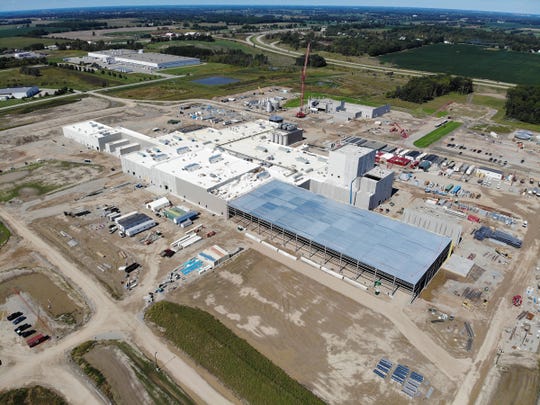
It sits in the St. Johns industrial park, amid construction trailers and equipment, one of three structures being built on 146 acres as part of what is expected to be the largest food-processing plant in Michigan.
Glanbia, an Irish food and nutrition company, announced plans for the $470 million cheese plant last August. The project also includes an adjacent $85 million adjacent facility belonging to Proliant Dairy Ingredients, an Iowa company.
Glanbia will own 50% of the milk processing facility. Dairy Farmers of America and Select Milk Producers, large dairy cooperative investors, will own the other half.
It will be state-of-the-art, and employ about 250 people, said John Dardis, senior vice president of U.S. corporate affairs for Glanbia.
The new St. Johns operation is modeled after a Glanbia and Dairy Farmers of America and Select Milk Producers partnership in New Mexico, Southwest Cheese Company LLC.
The latest expansion of that operation was last year, Dardis said.
Today the plant in New Mexico, which also produces cheese and whey, processes 14 million pounds of milk daily and employs more than 400 people, more than doubling the milk it processed since it opened in 2006.
Its success is a reassurance, Dardis said, that there’s demand for the operation under construction in St. Johns.
It is also a good sign that the facility could grow in the future, he said.
“Cheese demand is strong, and the dairy ingredient stream has become a real value product,” Dardis said. “It’s the same dynamic that’s driving Southwest Cheese, so we’re confident about those dynamics into the future. We wouldn’t be building it with our partners if we weren’t.”
Making progress
When it’s finished the St. Johns milk processing facility will capture about 20% of Michigan’s milk, said Glanbia Project Manager John Murphy. Right now, however, it’s an active build site, where an estimated 350 to 400 people go to work every day.
The walls of the milk processing facility went up in February, Murphy said. Since then crews have been building out its refrigeration area, installing 50-foot storage tanks, laying tile flooring and building an intricate pipe system that will run throughout the building transporting milk and water.
Glanbia’s 75,000-square-foot cheese-making area is taking shape too. A large cheese-belt, where milk curds will be separated from whey, was installed in August.
“These rooms look enormous but they fill up pretty quickly,” Murphy said during a recent walk-through of the building.
Roughly 800,000 pounds of American-style cheddar cheese will be made on site every day when the facility opens. Most of it will be cut into 40-pound blocks, packaged and shipped to retailers and food service and ingredient companies.
“From the moment the milk is pumped out of the silos (and comes) in to be pasteurized, and comes out as cheese in a package is a couple hours,” Murphy said. “It’s very quick.”
Glanbia will concentrate the protein from the whey, creating another byproduct called permeate. Proliant, the Iowa company, will dry the permeate into powdered dairy solids used in making baked goods, confectionery products, beverages and animal feed.
The Glanbia facility will operate 24 hours a day, seven days a week, Murphy said. Between 100 to 125 trucks carrying milk each day will get to the facility on Walker Road.
“The milk never really stops coming,” he said.
The milk processing plant is being built under the assumption it will expand, Murphy said.
“You can’t make predictions, but we have designed and built this with the assumption that it will,” he said.
The plant won’t have the capacity to process more than 8 million pounds of milk a day, Dardis said, so increasing production would require an expanded footprint.
The dairy operation currently occupies 30% of the city’s industrial park, St. Johns Community Development Director Dave Kudwa said. There are an additional 20 acres of land within it that hasn’t be developed yet.
Hopes for the future
Right now milk from Kevin Weber’s third-generation dairy farm in Leslie is trucked as far away as Wisconsin and Pennsylvania to be processed.
Milk from his cows will go to Clinton County when the milk processing operation opens, he said.
“It will benefit us by keeping our milk more local and it will reduce some of the hauling to get our milk processed,” Weber, 53, said.
He isn’t the only one with high hopes for the St. Johns operation.
Murphy gives two or three site tours a week at the property, to local and state officials, legislators and dairy farmers.
He’s “lost count” of how many there have been, he said.
St. Johns City Manager Jon Stoppels got a closer look at the operation on a recent tour.
“Anytime you go into it for the first time you’re impressed,” he said. The scale of the operation and the efficient, precise way it will operate is encouraging, Stoppels said. So is its potential to boost the city’s economy and population.























